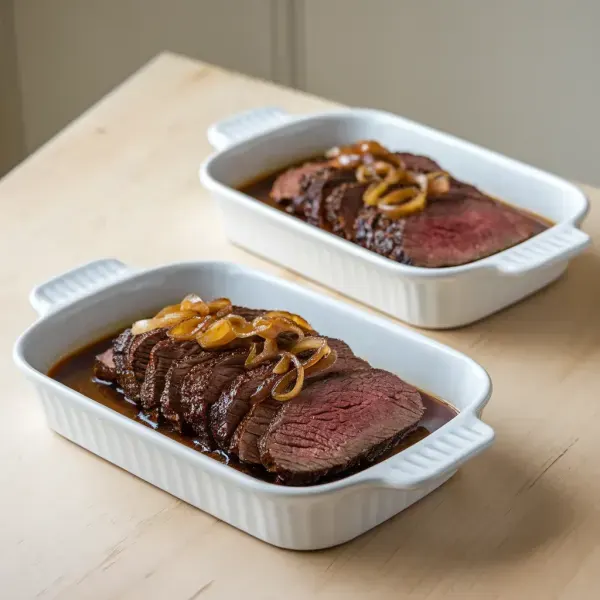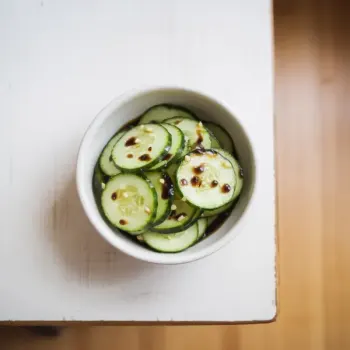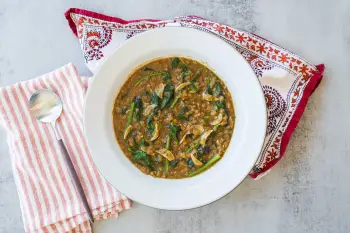
 860 minutes
860 minutesA tender and flavorful beef brisket braised with onions and a rich sauce.


Beef Brisket, flat cut preferred
0 lb
to taste
to taste
teaspoons
Large Onion, halved and sliced 1/2 inch thick
0 lb
tablespoons
Garlic, minced or pressed through garlic press
each
tablespoons
tablespoons
teaspoons
tablespoons
Low-Sodium Chicken Broth
cups
cups
each
sprigs
teaspoons
1. Preheat Oven
Preheat your oven by adjusting the rack to the lower-middle position and setting the temperature to 300 degrees Fahrenheit. This ensures even cooking for the brisket.
2. Prepare Baking Dish
Line a 13 by 9-inch baking dish with two sheets of foil, arranging them perpendicularly so the excess extends beyond the edges. This setup will make it easier to handle the brisket later.
3. Season and Brown Brisket
Pat the brisket dry with paper towels and use a dinner fork to poke holes in the fat layer. Season it generously with salt and ground black pepper. Heat a teaspoon of vegetable oil in a skillet over medium-high heat. When the oil is shimmering, place the brisket fat side up in the skillet. Use a Dutch oven to weigh it down, cooking for about 7 minutes. Flip the brisket and cook for another 7 minutes until both sides are well-browned. This step locks in the juices and creates a flavorful crust.
4. Caramelize Onions
Pour off the excess fat from the skillet, leaving behind a small amount. Add the sliced onions, brown sugar, and a pinch of salt to the skillet. Cook, stirring occasionally, for 10 to 12 minutes until the onions are softened and caramelized.
5. Add Garlic and Tomato Paste
Add the minced garlic and cook for another minute until fragrant. Stir in the tomato paste and cook for 2 minutes.
6. Add Paprika and Cayenne
Add the paprika and cayenne pepper to the skillet and cook for an additional minute. Sprinkle the flour over the onions and cook for 2 more minutes to eliminate the raw flour taste.
7. Prepare Sauce
Pour in the chicken broth and red wine, and add the bay leaves and thyme sprigs. Scrape up any browned bits from the bottom of the skillet as the mixture comes to a simmer. Let it cook for about 5 minutes to meld all the flavors.
8. Transfer to Baking Dish
Transfer the onion mixture and sauce into the foil-lined baking dish. Nestle the browned brisket into the sauce, fat side up. Loosely seal the foil over the brisket and place the dish in the oven. Bake for 3.5 to 4 hours until the brisket is tender.
9. Cool Brisket
Once cooked, open the foil and let the brisket cool for 20 to 30 minutes. This resting time allows the juices to redistribute throughout the meat.
10. Refrigerate Overnight
Transfer the brisket to a bowl and strain the sauce through a mesh strainer into another bowl. Discard the bay leaves and thyme. Cover both bowls with plastic wrap and refrigerate overnight.
11. Reheat Brisket and Sauce
The next day, preheat your oven to 350 degrees Fahrenheit. Remove the brisket and sauce from the refrigerator. Scrape off any solidified fat from the surface of the sauce. Reheat the sauce in a saucepan over medium heat. Slice the brisket against the grain into 1/4-inch thick slices.
12. Finish Sauce and Serve
Stir the caramelized onions and cider vinegar into the reheated sauce. Arrange the brisket slices in a baking dish and pour the sauce over them. Cover the dish with foil and bake for 25 to 30 minutes until everything is heated through.
Beef Bourguignon, Italian Pot Roast (Stracotto), Asian-style Brisket . using the core recipe to explore different international flavor profiles.
Pork shoulder (Pulled Pork), Lamb shoulder (Braised Lamb), Chicken thighs (Braised Chicken) . adapting the core technique of slow braising to various meats and flavor profiles.
Tacos, Sandwiches, Over Polenta or Mashed Potatoes . presenting the braised meat in various serving formats for a diverse dining experience.
Introduce a splash of balsamic vinegar or pomegranate molasses to the braising liquid. The acidity and sweetness will offer a counterpoint to the richness of the brisket, providing a subtle but distinctive change.
Introduce a bit of umami with ingredients like a tablespoon of tomato paste, a splash of soy sauce, or a few anchovy fillets melted into the braising liquid. These will deepen the savory notes without overpowering the dish.
Look for a cut with marbling throughout for a juicier result. The point cut has more fat and flavor, while the flat cut is leaner and slices neatly.
Dry brine your brisket at least the night before cooking to enhance flavor and tenderness.
Allow the brisket to rest for at least 20 minutes after cooking and slice against the grain for tenderness.
Cook your brisket at a low temperature (around 300°F/150°C) for long periods to break down connective tissue.
Properly sear the brisket on all sides to develop deep flavors that enhance the entire dish.




Comments (0)